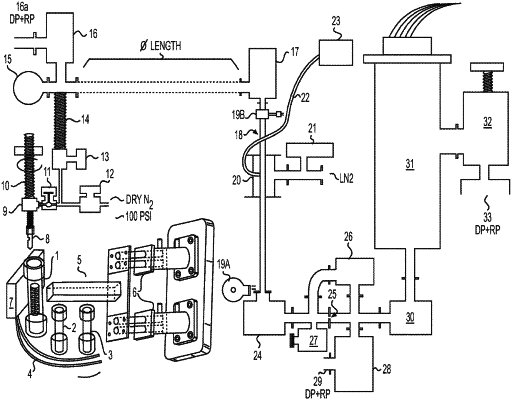| CPC G01N 3/08 (2013.01) [G01N 33/241 (2013.01); G01N 2203/0019 (2013.01); G01N 2203/0076 (2013.01)] | 13 Claims |

|
1. A method for analyzing substances in a non-gaseous material comprising:
(1) providing an analyzable amount of a non-gaseous material;
(2) applying force to the material causing the release of a first gas from the material, the first gas released from the material containing an analyzable amount of a substance, wherein the force comprises exposing the material to a vacuum at a negative pressure of 1×10−5 millibars or more;
(3) trapping and concentrating a trappable portion of the first gas in or with a cryogenic trap in an analyzable amount to generate a trapped gas aliquot:
(4) isolating the trapped gas aliquot from the material;
(5) releasing a portion of the trapped gas aliquot to form a released gas aliquot;
(6) analyzing the chemistry of the released gas aliquot through mass spectrometry to obtain an analysis of the substance in the trapped gas aliquot; and
(7) repeating steps (2)-(6) of the method for at least one additional cycle, wherein step (2) is applied to the same material in the initial performance of the method and each additional cycle, the force applied to the material in at least a first cycle of the cycles comprising the initial performance of the method and each additional cycle is different from the force applied to the material in at least a second cycle of the cycles thereby causing the release of a different first gas in the first cycle from the first gas released in the second cycle and wherein the first gas of the first cycle and first gas of the second cycle are trapped, isolated, released, and analyzed separately from one another.
|